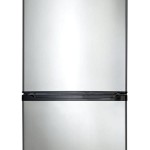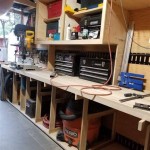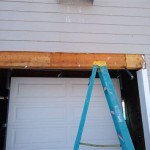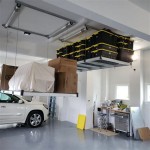How to Hang an Extension Ladder in Your Garage: A Comprehensive Guide
Storing an extension ladder in a garage can present a challenge, particularly if space is limited. Laying it on the floor consumes valuable area, while leaving it leaning against a wall can be unstable and pose a safety hazard. Hanging the ladder vertically or horizontally from the garage ceiling or wall offers an efficient and secure storage solution. This article provides a step-by-step guide on how to hang an extension ladder in a garage, emphasizing safety and proper installation techniques.
Before commencing the installation, it is crucial to assess the available space and the weight of the ladder. Extension ladders can be quite heavy, so the mounting hardware and support structure must be robust enough to handle the load. Carefully consider the location where the ladder will be hung, ensuring it doesn't obstruct access to vehicles, doorways, or other essential areas within the garage. Safety should always be the paramount concern throughout the entire process.
Key Point 1: Assessing Your Garage and Selecting Appropriate Hardware
The first step involves thoroughly evaluating the garage structure and selecting suitable mounting hardware. This encompasses identifying the type of walls or ceiling joists available and determining their load-bearing capacity. Improper assessment and hardware selection can lead to a collapse of the mounting system, resulting in damage to the ladder, the garage structure, and potential injuries.
Wall Assessment: Determine if the garage walls are constructed of drywall, concrete, or wood studs. Drywall alone is generally insufficient to support the weight of an extension ladder; therefore, find the underlying studs. Stud finders are readily available and can accurately locate the studs behind drywall. Concrete walls will require specialized anchors designed for masonry.
Ceiling Assessment: If opting to hang the ladder from the ceiling, identify the type of ceiling joists. Common options include wood joists and metal I-beams. Wood joists should be inspected for any signs of rot or damage before attaching any hardware. For metal I-beams, specialized clamps or bolted connections are necessary.
Hardware Selection: Based on the wall or ceiling type, select appropriate mounting hardware. For wood studs, heavy-duty screws or lag bolts are recommended. The length of the screws or lag bolts should be sufficient to penetrate deeply into the stud, typically at least 2-3 inches. For concrete walls, use concrete anchors that are rated for the weight of the ladder. For hanging from the ceiling, consider purchasing ladder hooks or straps designed for garage storage. These hooks are typically made of heavy-duty steel and have a significant weight capacity. In addition to the primary mounting hardware, ensure you have washers to distribute the load and prevent the screw or bolt head from pulling through the mounting surface.
Weight Capacity: Always check the weight rating of all hardware and ensure it exceeds the total weight of the extension ladder by a significant margin. A safety factor of at least 2 is recommended. This means the hardware should be able to support at least twice the weight of the ladder to account for dynamic loads or accidental impacts.
Tools Required: Before starting the installation, gather the necessary tools. These may include a stud finder, drill, level, measuring tape, socket wrench or adjustable wrench, safety glasses, and work gloves. Using the correct tools will ensure a safer and more efficient installation process.
Finally, before purchasing any hardware, take precise measurements of your ladder. This includes the overall length and the width at its widest point. Knowing these dimensions will help you choose hardware that is appropriately sized and ensure the ladder fits securely in its storage location.
Key Point 2: Installing the Mounting Hardware
Once the garage structure has been assessed and the appropriate hardware has been selected, the next step is to install the mounting brackets or hooks. Proper installation is critical to ensure the ladder is securely and safely stored. This section details the process for installing hardware on both walls and ceilings.
Wall Installation: Begin by marking the location of the studs on the wall using a stud finder and a pencil. Measure the distance between the studs to ensure the mounting brackets or hooks will align correctly. Use a level to ensure the brackets are installed at the same height, preventing the ladder from tilting. Drill pilot holes into the studs at the marked locations. The pilot holes should be slightly smaller than the diameter of the screws or lag bolts being used. This will make it easier to drive the screws and prevent the wood from splitting. Attach the mounting brackets or hooks to the studs using the screws or lag bolts. Tighten the screws securely, but avoid over-tightening, which can strip the threads or damage the wood. If using concrete anchors, follow the manufacturer's instructions for drilling the appropriate size hole and inserting the anchors. Ensure the anchors are fully seated and securely fastened.
Ceiling Installation: Locate the ceiling joists and mark their positions. Similar to wall installation, measure the distance between the joists to ensure proper bracket alignment. Use a level to ensure the brackets are installed parallel to each other. Drill pilot holes into the joists at the marked locations. The pilot holes should be slightly smaller than the diameter of the screws or lag bolts being used. Attach the mounting brackets or hooks to the joists using the screws or lag bolts. Tighten the screws securely, but avoid over-tightening. If using metal I-beam clamps, ensure the clamps are properly sized for the I-beam and are tightened according to the manufacturer's instructions. For bolted connections to metal I-beams, pre-drill holes and use appropriately sized bolts and nuts. Ensure the bolts are tightened to the correct torque specification to prevent loosening over time.
Spacing Considerations: When installing multiple brackets or hooks, space them evenly along the length of the ladder. This will distribute the weight evenly and prevent unnecessary stress on any single point. A general rule of thumb is to place brackets or hooks every 4-6 feet along the ladder's length. Ensure the spacing also aligns with available studs or joists, as direct attachment to structural members is essential.
Safety Checks: After installing the hardware, conduct a thorough safety check. Pull on the brackets or hooks to ensure they are securely attached and can withstand significant force. If any movement or instability is detected, re-tighten the fasteners or consider using larger or stronger hardware. It is better to err on the side of caution and ensure the mounting system is robust enough to handle the weight of the ladder safely.
Key Point 3: Hanging the Ladder and Ensuring Stability
Once the mounting hardware is securely installed, the final step is to hang the extension ladder and verify its stability. This requires careful lifting and positioning of the ladder to prevent damage or injury. Regularly inspecting the installation is important to guarantee long-term security.
Lifting and Positioning: With assistance, carefully lift the extension ladder and position it onto the installed brackets or hooks. Ensure the ladder is evenly supported and that the weight is distributed across all mounting points. Avoid dropping the ladder onto the brackets, as this can damage both the ladder and the mounting hardware. If the ladder is particularly heavy, consider using a lifting aid or seeking additional assistance to make the process easier and safer.
Securing the Ladder: Depending on the type of mounting hardware used, you may need to secure the ladder in place. Some ladder hooks have built-in locking mechanisms that prevent the ladder from accidentally falling. If no locking mechanism is present, consider using straps or bungee cords to secure the ladder to the brackets. This will provide an extra layer of protection and prevent the ladder from being dislodged by vibrations or accidental bumps.
Stability Check: After hanging the ladder, perform a final stability check. Gently push and pull on the ladder to ensure it is securely in place and does not wobble or swing excessively. If any instability is detected, re-adjust the ladder or add additional support to the mounting system. Pay close attention to the points where the ladder rests on the brackets or hooks, ensuring there is sufficient surface contact and no slippage.
Regular Inspection: Periodically inspect the mounting hardware for any signs of wear or damage. Check for loose screws, cracked brackets, or corroded anchors. If any issues are detected, promptly repair or replace the affected components. Regularly inspect the ladder itself for any signs of damage, such as bent rungs or cracked side rails. Using a damaged ladder can be extremely dangerous.
Safety Considerations: Keep the area around the stored ladder clear of obstructions. This will ensure easy access to the ladder when needed and prevent accidental tripping hazards. Consider placing a warning sign near the ladder to alert others to its presence and remind them to exercise caution. If the ladder is stored in a high-traffic area, consider installing a barrier or guard rail to prevent accidental contact.
By following these steps, individuals can effectively and safely hang an extension ladder in a garage, maximizing space and ensuring the ladder is stored securely. Remember that prioritizing safety throughout the entire process is paramount.

Ladder Storage Ideas

Garage Ceiling Storage For Surfboards And Ladders

Ladder Hanger You Can Hang From

Ladder Hooks For Garage Ceiling 15 3 Wall Mounted Storage 1 Minute Review

How To Hang A Ladder From The Ceiling

Hang Up Your Extension Ladder The Easy Way Fun With Pulleys

22 Clever Storage Ideas For Stuff That S Always In The Way Diy Garage Ladder
:max_bytes(150000):strip_icc()/121003510_1057830077990355_3746717106631243077_n1-bf709f786882483280a19767b56fce00.jpg?strip=all)
11 Ladder Storage Ideas You Ll Want To Copy

How To Hang A Ladder From The Ceiling 12 Steps With Pictures

Ladder Storage Made Easy The Lift From Racor
Related Posts








